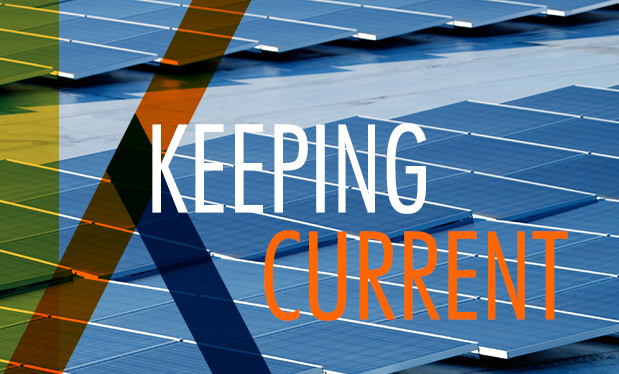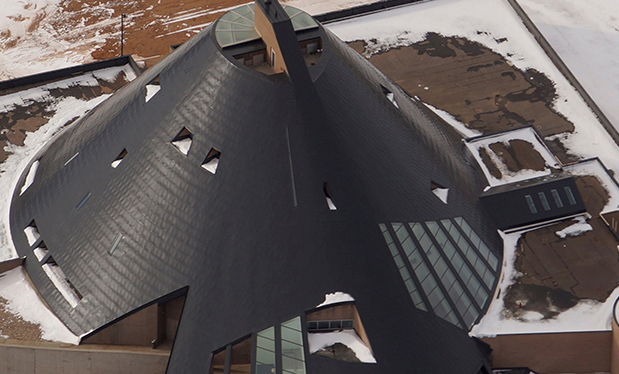Oil canning sometimes is an undesirable aesthetic concern associated with metal panel roof systems and architectural metal flashings. The following is a discussion of some possible causes of and remedies for oil canning.
What is it?
Oil canning is best defined as a visible waviness in the flat areas of metal roof panels, wall panels or architectural metal flashings. It is characterized as a moderate deformation or buckling of the sheet material, particularly common on flat metal sheet surfaces.
Oil canning also refers to the popping sound made when pressure is applied to a deformed sheet forcing the deformation in the opposite direction.
Oil canning is inherent to some degree on all metal surfaces. Because some paint finishes, clear coats and metals are highly reflective and bright, distortions can be quite apparent, and the visual effects of oil canning can be exacerbated by changing or varying light conditions. Conditions such as the time of year, the angle at which sunlight strikes a metal surface and a person's viewing angle affect the ability to discern oil canning.
NRCA does not consider oil canning to be a cause for rejection; it does not have any adverse effect on a metal's structural integrity or waterproofing capability.
Causes
There are a number of causes of oil canning; however, all are attributable to stresses that remain in a solid material after the original source of the stresses has been removed.
For example, such residual stresses induced during metal coil production can contribute to a slight camber, or deviation of a side edge from a straight line, in the metal. This longitudinal curve will result in additional stresses being placed on the metal as it is brake-formed or pulled through a roll-forming machine, which attempts to form a straight edge on the panel.
Also, cutting or slitting a master coil can partially release and redistribute stresses, especially if a slitter blade is out of adjustment or relatively dull.
Roll-forming equipment can cause oil canning, as well. As metal is run through the multiple rolling stations within a roll former, it is placed under additional stress and can stretch slightly, particularly if the equipment is out of adjustment or operating beyond its limitations.
In addition, oil canning can occur when metal is installed and can result from temperature fluctuations and cycles; an uneven substrate or irregular bearing on structural framing; structural movement; or misalignment of attachment points or clips.
Remedies
If a specifier intends to reduce oil canning's severity, careful design consideration needs to be given to the width, thickness (gauge), profile, color and gloss of the specific metal product.
NRCA offers the following guidelines for specifiers' consideration. Specifiers should:
- Specify metal coil stock to be tension-leveled to ensure flatness of the metal stock material. Tension-leveling is a mechanical operation in which the metal coil is stretched slightly beyond its yield point to induce flatness.
- Use heavier-gauge metal that is more rigid and less likely to result in oil canning than lighter-gauge metal.
- Use expansion clips instead of fixed clips.
- Use low-gloss metal finishes or special surface textures such as embossing or striations.
- Use metals that weather naturally; these metals typically dull or fade over time and develop a layer of oxidation.
- Limit face dimensions, and use face extenders for wide profile shapes.
- Use minor ribs, stiffening ribs, V-grooves or cross-breaks to limit flat-face dimensions.
Closing thoughts
Many factors, some uncontrollable, contribute to oil canning. No designer, panel manufacturer, metal fabricator or installer can ensure an installation free of oil canning on any given project.
Additional information about oil canning, its causes and design considerations for limiting its appearance is included in the Condensation and Air Leakage Control section of The NRCA Roofing Manual: Architectural Metal Flashing, Condensation and Air Leakage Control, and Reroofing—2014. A digital version of the manual is available free to NRCA members on shop.nrca.net and on the NRCA App, which is available through the Apple App Store, Google Play or Windows Store. The hard-copy version is available for purchase through the NRCA Bookstore.
Mark S. Graham is NRCA's vice president of technical services.



